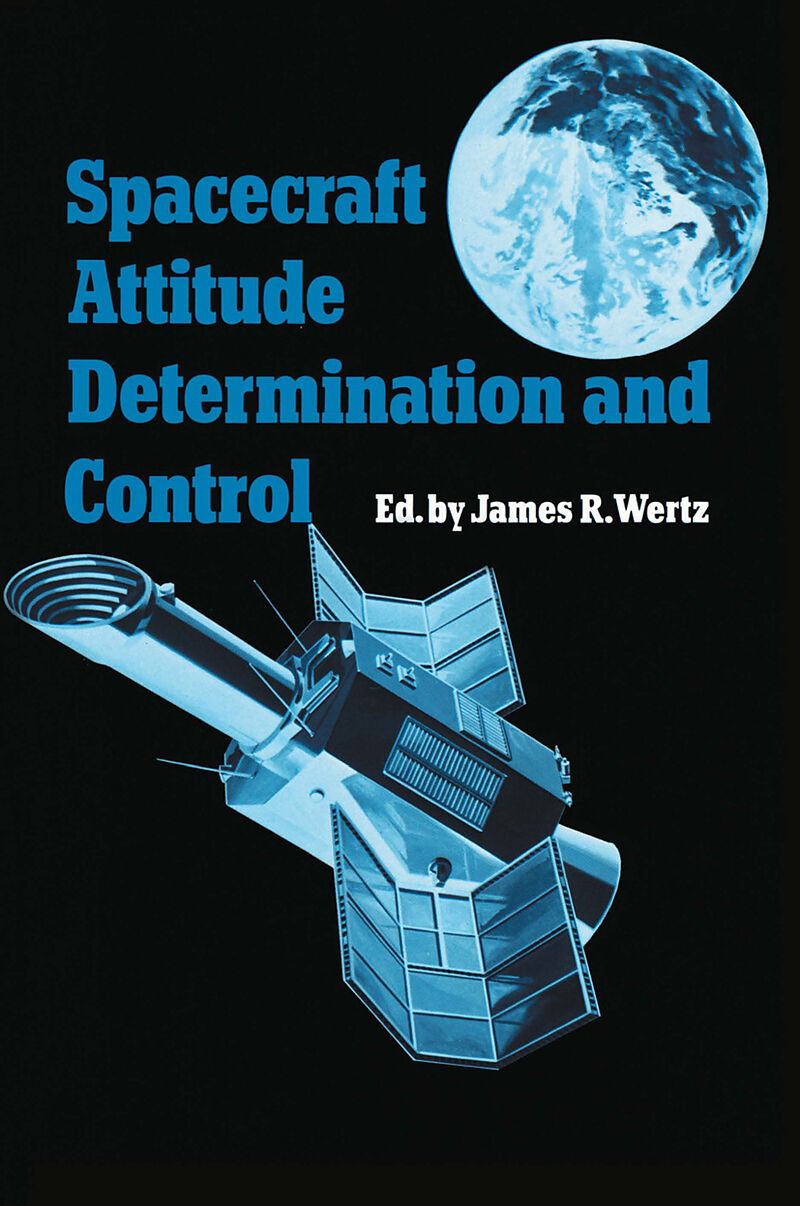Spacecraft Attitude Determination and Control
Format:
E-Book (pdf)
EAN:
9789400999077
Genre:
Technik
Herausgeber:
Springer Netherlands
Anzahl Seiten:
858
Erscheinungsdatum:
06.12.2012
Roger D. Werking Head, Attitude Determination and Control Section National Aeronautics and Space Administration/ Goddard Space Flight Center Extensiye work has been done for many years in the areas of attitude determination, attitude prediction, and attitude control. During this time, it has been difficult to obtain reference material that provided a comprehensive overview of attitude support activities. This lack of reference material has made it difficult for those not intimately involved in attitude functions to become acquainted with the ideas and activities which are essential to understanding the various aspects of spacecraft attitude support. As a result, I felt the need for a document which could be used by a variety of persons to obtain an understanding of the work which has been done in support of spacecraft attitude objectives. It is believed that this book, prepared by the Computer Sciences Corporation under the able direction of Dr. James Wertz, provides this type of reference. This book can serve as a reference for individuals involved in mission planning, attitude determination, and attitude dynamics; an introductory textbook for stu dents and professionals starting in this field; an information source for experimen ters or others involved in spacecraft-related work who need information on spacecraft orientation and how it is determined, but who have neither the time nor the resources to pursue the varied literature on this subject; and a tool for encouraging those who could expand this discipline to do so, because much remains to be done to satisfy future needs.
Inhalt
I-Background.- 1. Introduction.- 1.1 Representative Mission Profile.- 1.2 Representative Examples of Attitude Determination and Control.- 1.3 Methods of Attitude Determination and Control.- 1.4 Time Measurements.- 2. Attitude Geometry.- 2.1 The Spacecraft-Centered Celestial Sphere.- 2.2 Coordinate Systems.- 2.3 Elementary Spherical Geometry.- 3. Summary of Orbit Properties and Terminology.- 3.1 Keplerian Orbits.- 3.2 Planetary and Lunar Orbits.- 3.3 Spacecraft Orbits.- 3.4 Orbit Perturbations.- 3.5 Viewing and Lighting Conditions.- 4. Modeling the Earth.- 4.1 Appearance of the Earth at Visual Wavelengths.- 4.2 Appearance of the Earth at Infrared Wavelengths.- 4.3 Earth Oblateness Modeling.- 4.4 Modeling the Structure of the Upper Atmosphere.- 5. Modeling the Space Environment.- 5.1 The Earth's Magnetic Field.- 5.2 The Earth's Gravitational Field.- 5.3 Solar Radiation and the Solar Wind.- 5.4 Modeling the Position of the Spacecraft.- 5.5 Modeling the Positions of the Sun, Moon, and Planets.- 5.6 Modeling Stellar Positions and Characteristics.- II-Attitude Hardware and Data Acquisition.- 6. Attitude Hardware.- 6.1 Sun Sensors.- 6.2 Horizon Sensors.- 6.3 Magnetometers.- 6.4 Star Sensors.- 6.5 Gyroscopes.- 6.6 Momentum and Reaction Wheels.- 6.7 Magnetic Coils.- 6.8 Gas Jets.- 6.9 Onboard Computers.- 7. Mathematical Models of Attitude Hardware.- 7.1 Sun Sensor Models.- 7.2 Horizon Sensor Models.- 7.3 Sun Sensor / Horizon Sensor Rotation Angle Models.- 7.4 Modeling Sensor Electronics.- 7.5 Magnetometer Models.- 7.6 Star Sensor Models.- 7.7 Star Identification Techniques.- 7.8 Gyroscope Models.- 7.9 Reaction Wheel Models.- 7.10 Modeling Gas Jet Control Systems.- 8. Data Transmission and Preprocessing.- 8.1 Data Transmission.- 8.2 Spacecraft Telemetry.- 8.3 Time Tagging.- 8.4 Telemetry Processors.- 9. Data Validation and Adjustment.- 9.1 Validation of Discrete Telemetry Data.- 9.2 Data Validation and Smoothing.- 9.3 Scalar Checking.- 9.4 Data Selection Requiring Attitude Information.- III-Attitude Determination.- 10. Geometrical Basis of Attitude Determination.- 10.1 Single-Axis Attitude.- 10.2 Arc-Length Measurements.- 10.3 Rotation Angle Measurements.- 10.4 Correlation Angles.- 10.5 Compound Measurements-Sun to Earth Horizon Crossing Rotation Angle.- 10.6 Three-Axis Attitude.- 11. Single-Axis Attitude Determination Methods.- 11.1 Methods for Spinning Spacecraft.- 11.2 Solution Averaging.- 11.3 Single-Axis Attitude Determination Accuracy.- 11.4 Geometrical Limitations on Single-Axis Attitude Accuracy.- 11.5 Attitude Uncertainty Due to Systematic Errors.- 12. Three-Axis Attitude Determination Methods.- 12.1 Parameterization of the A ttitude.- 12.2 Three-Axis Attitude Determination.- 12.3 Covariance Analysis.- 13. State Estimation Attitude Determination Methods.- 13.1 Deterministic Versus State Estimation Attitude Methods.- 13.2 State Vectors.- 13.3 Observation Models.- 13.4 Introduction to Estimation Theory.- 13.5 Recursive Least-Squares Estimators and Kaiman Filters.- 14. Evaluation and Use of State Estimators.- 14.1 Prelaunch Evaluation of State Estimators.- 14.2 Operational Bias Determination.- 14.3 Limitations on State Vector Observability.- IV-Attitude Dynamics and Control.- 15. Introduction to Attitude Dynamics and Control.- 15.1 Torque-Free Motion.- 15.2 Response to Torques.- 15.3 Introduction to Attitude Control.- 16. Attitude Dynamics.- 16.1 Equations of Motion.- 16.2 Motion of a Rigid Spacecraft.- 16.3 Spacecraft Nutation.- 16.4 Flexible Spacecraft Dynamics.- 17. Attitude Prediction.- 17.1 Attitude Propagation.- 17.2 Environmental Torques.- 17.3 Modeling Internal Torques.- 17.4 Modeling Torques Due to Orbit Maneuvers.- 18. Attitude Stabilization.- 18.1 A utomatic Feedback Control.- 18.2 Momentum and Reaction Wheels.- 18.3 Autonomous Attitude Stabilization Systems.- 18.4 Nutation and Libration Damping.- 19. Attitude Maneuver Control.- 19.1 Spin Axis Magnetic Coil Maneuvers.- 19.2 Spin Plane Magnetic Coil Maneuvers.- 19.3 Gas Jet Maneuvers.- 19.4 Inertial Guidance Maneuvers.- 19.5 Attitude Acquisition.- V-Mission Support.- 20. Software System Development.- 20.1 Safeguards Appropriate for Mission Support Software.- 20.2 Use of Graphic Support Systems.- 20.3 Utility Subroutines.- 21. Software System Structure.- 21.1 General Structure for A ttitude Software Systems.- 21.2 Communications Technology Satellite Attitude Support System.- 21.3 Star Sensor Attitude Determination System.- 21.4 Attitude Data Simulators.- 22. Discussion.- VI-Appendices.- Appendix A-Spherical Geometry.- Appendix B-Construction of Global Geometry Plots.- Appendix C-Matrix and Vector Algebra.- Appendix D-Quaternions.- Appendix E-Coordinate Transformations.- Appendix F-The Laplace Transform.- Appendix G-Spherical Harmonics.- Appendix H-Magnetic Field Models.- Appendix I-Spacecraft Attitude Determination and Control Systems.- Appendix J-Time Measurement Systems.- Appendix K-Metric Conversion Factors.- Appendix L-Solar System Constants.- Appendix M-Fundamental Physical Constants.

Leider konnten wir für diesen Artikel keine Preise ermitteln ...
billigbuch.ch sucht jetzt für Sie die besten Angebote ...
Die aktuellen Verkaufspreise von 3 Onlineshops werden in Realtime abgefragt.
Sie können das gewünschte Produkt anschliessend direkt beim Anbieter Ihrer Wahl bestellen.
Loading...
Die aktuellen Verkaufspreise von 3 Onlineshops werden in Realtime abgefragt.
Sie können das gewünschte Produkt anschliessend direkt beim Anbieter Ihrer Wahl bestellen.
| # | Onlineshop | Preis CHF | Versand CHF | Total CHF | ||
|---|---|---|---|---|---|---|
| 1 | Seller | 0.00 | 0.00 | 0.00 |
